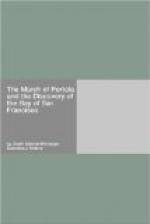All the bay, which is called the round bay (Bahia Redondo), though it is not shaped that way, is surrounded with steep hills, without trees, excepting two spots on the slopes fronting the two harbors to the southwest. The rest of it is arid, rugged, and of a melancholic aspect. Outside of the channels there is in this bay about five codos of water, and at low tide two and a half, and in some places it is dry. It is not difficult to enter this bay, but going out will be difficult on account of the wind from the southwest. After a careful examination of its shore, I did not find any fresh water or any signs of it. Standing in the canon, which is to the northeast, there is a channel[75] a mile and a half wide, deep and clear. East of its entrance there is a rancheria of about four hundred souls. I had dealings with them, but did not buy anything, though I presented them with beads, which you had given me for that purpose, and some old clothing of mine. Their acquaintance was useful to my men and to me, as they presented us with exquisite fishes (amongst them salmon), seeds, and pinole. I had opportunity of visiting them four times and found them always as friendly as the first time, noticing in them polite manners, and what is better, modesty and retirement in the women. They are not disposed to beg, but accept with good will what is given them, without being impertinent, as are many others I have seen during the conquest. This Indian village has some scows or canoes, made of tule, so well constructed and woven that they caused me great admiration. Four men get in them to go fishing, pushing with two-ended oars with such speed that I found they went faster than the launch. These were the only Indians with whom I had communication in this northern part.
Following said channel a distance to the west from its mouth, there is a harbor, so commodious, accessible, abundant in fresh water and wood, and sheltered from all winds, that I considered it one of the best inland ports that our Sovereign has for anchoring a fleet of vessels. I called it Puerto de la Asumpta, having examined it the day of the festivity of that saint[76].
To the southeast of this port[77] the canon continues, until it joins the channel of the Indian village. Following a distance of three leagues in an east-northeast direction, it enters another bay[78] with a depth of thirteen brazas, diminishing to four where some rivers[79] empty and take the saltiness of the water which there becomes sweet, the same as in a lake. The rivers come, one from the east-northeast (this is the largest, about two hundred and fifty yards wide), the other, which has many branches, comes from the northeast through tulares and swamps in very low land, the channels not over two brazas with sandy bars at their mouths, where I found in sounding the water not more than a half braza. This made me think they were not navigable, especially as on the second occasion I entered them, I touched bottom both in the




